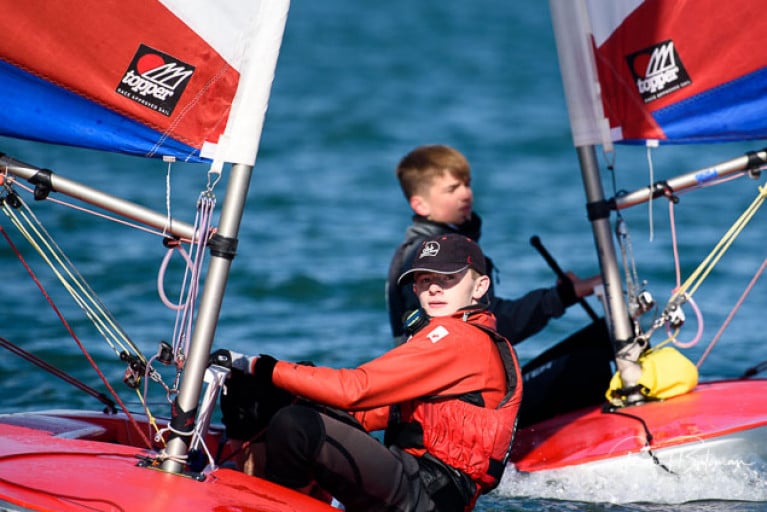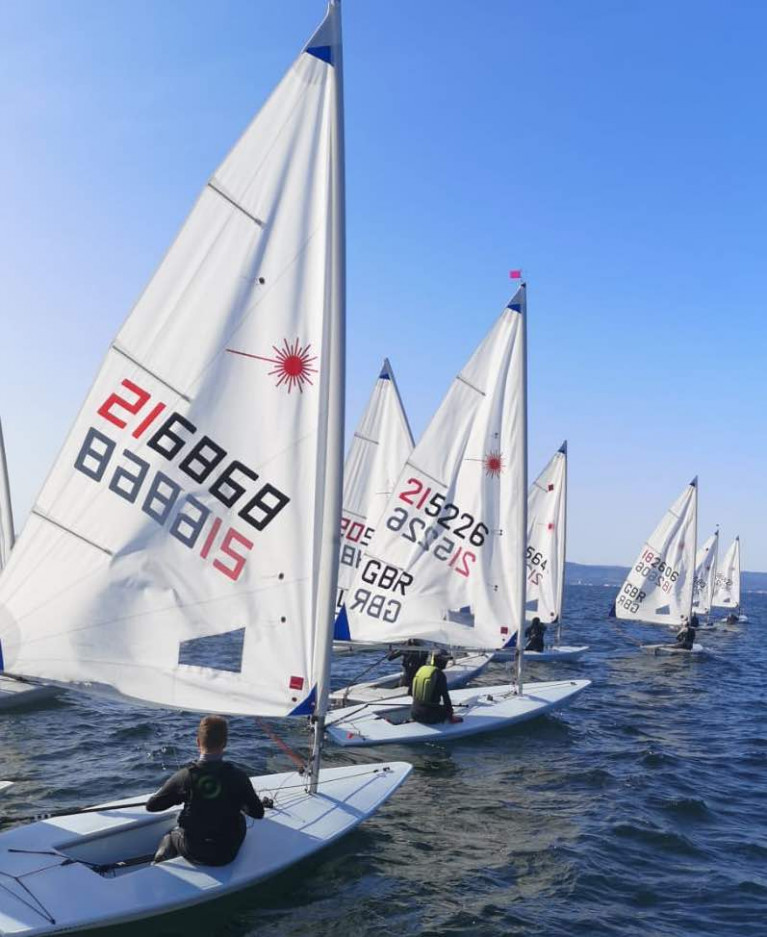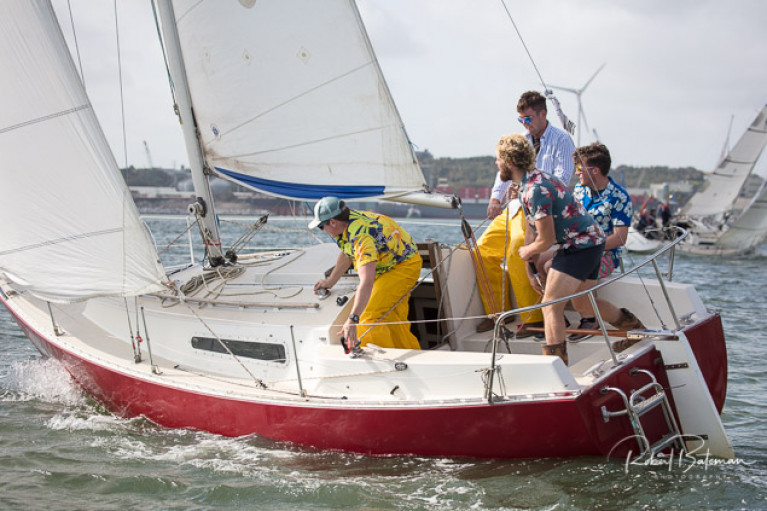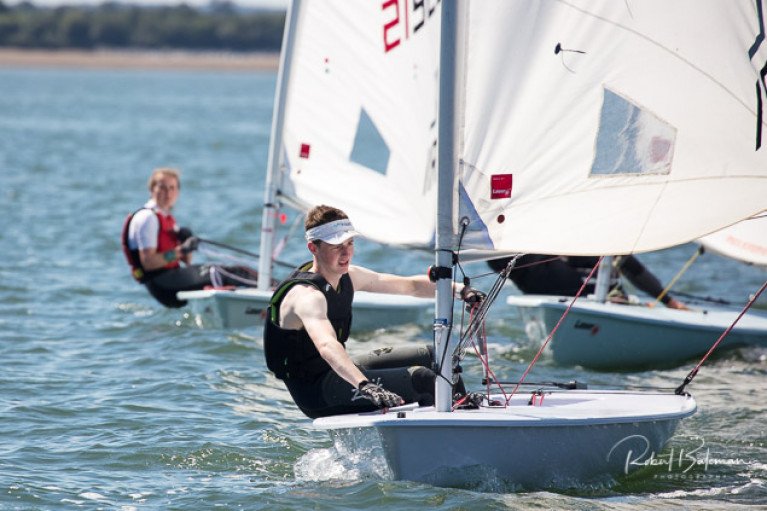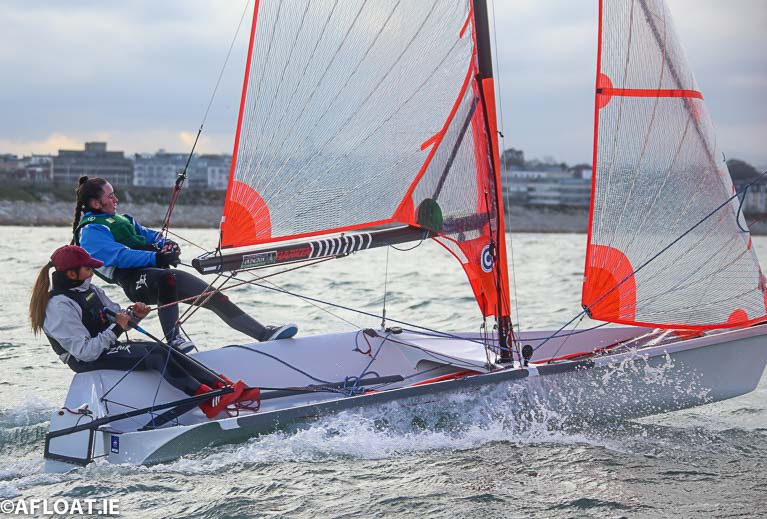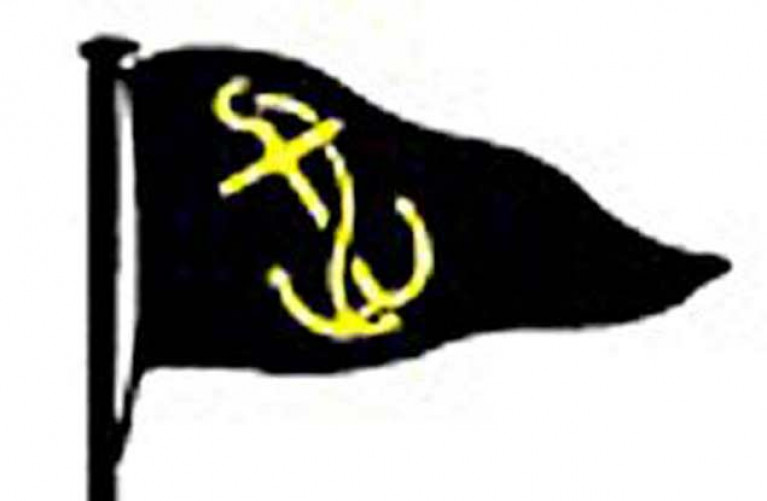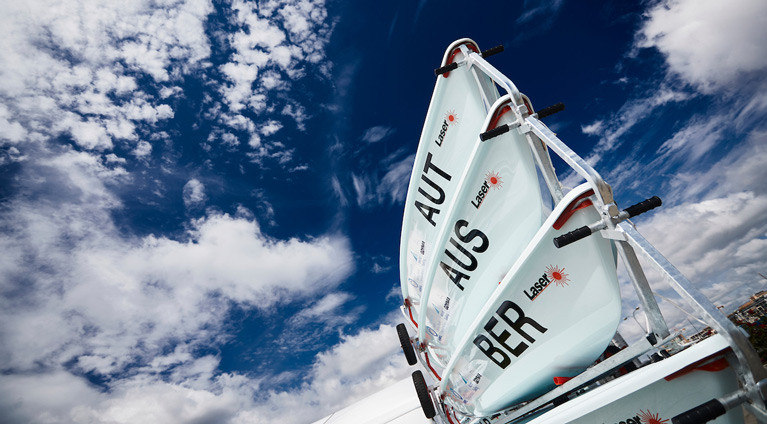Displaying items by tag: youth sailing
Crosbie Leads Radials in Royal Cork September League, Tolan Tops Toppers
In Royal Cork's September Saturday League for Toppers and Lasers, Cork Harbour youth sailors have enjoyed some great sailing conditions this autumn with eight races sailed so far for Laser Radials and 4.7s and six races for the Topper class.
Radial
After two discards, Michael Crosbie leads the Laser Radial by five points from Dorothy Matthews on 13.0 points. Third is Hugh Lynch on 26.0 points.
Topper
Max Tolan leads by five points after six races sailed from Julie O'Neill on 13 points with Craig O'Neill third on 18.
See results here and Bob Bateman's photo gallery below
90 Compete For Northern Ireland Youth Sailing Honours at Ballyholme Yacht Club
More than 90 of Northern Ireland’s Youth and Junior sailors have taken part in the RYA Northern Ireland Youth Championships, which were hosted by Ballyholme Yacht Club.
Racing took part of over two days on Saturday 19 and Sunday 20 September and the fleets were split to reduce overall numbers on site each day to mitigate risk in accordance with COVID – 19 guidelines.
The ILCA 6 and 420s took to the water on Saturday for five races in perfect conditions of 15 knots and sunshine.
Ellen Barbour from County Antrim Yacht Club showed good form early on to lead the way in race one, only to fall foul of being over at the start. This gave Coleraine Yacht Club’s Tom Coulter the win followed by Colin Crichton of Quoile Yacht Club in 2nd.
Race two saw Erin Mcllwaine from Newcastle Yacht Club was fast out of the blocks and took the win for race two with Crichton again runner up and Coulter in 3rd.
By race three Coulter started to show some dominance with his second win of the event followed by Ballyholme’s Oliver Haig.
The girls led the way in the fourth race with Mcllwaine doing her best to close the gap to Coulter with another win and Barbour a close 2nd to prove her performance in race one was not a one-off.
|
ILCA 6 |
ILCA 4 |
||
|
1st Overall |
Tom Coulter |
1st Overall |
Hannah Dadley-Young |
|
1st Boy |
Tom Coulter |
1st Boy |
Conor McVeigh |
|
1st Girl |
Erin Mcllwaine |
1st Girl |
Hannah Dadley-Young |
|
2nd |
Erin Mcllwaine |
2nd |
Eva Briggs |
|
3rd |
Joseph Karauzum |
3rd |
Conor McVeigh |
|
420 – Northern Championship |
|
|
1st Overall |
Ben Graf & Alexander Farrell |
|
2nd |
Jack McDowell & Harry Thomson |
|
3rd |
Garrett Leech & Conor Paul |
|
TOPPER |
TOPPER 4.2 |
||
|
1st Overall |
Zoe Whitford |
1st Overall |
Hugo Boyd |
|
1st Boy |
Dan Palmer |
1st Boy |
Hugo Boyd |
|
2nd Boy |
Max Killiner |
1st Girl |
Jessica Dadley-Young |
|
3rd Boy |
Charlie Patterson |
2nd |
Freddie Doig |
|
1st Girl |
Zoe Whitford |
3rd |
Mateo Moore |
|
2nd Girl |
Autumn Halliday |
||
|
3rd Girl |
Sophia Cahill |
||
|
RYANI Youth Championships Overall |
|
|
1st Junior |
Zoe Whitford |
|
1st Youth |
Tom Coulter |
|
1st Lady |
Erin Mcllwaine |
|
Club Trophy |
Ballyholme Yacht Club |
|
School’s Cup |
Larne Grammar |
George Radley Junior & Getting Young Sailors into Cruiser Racing – Buying an Old Boat
The Commodore of the South Coast Offshore Racing Association believes there are yachts "out there waiting for budding enthusiasts to give them a second or third chance" and which could be used to encourage the next generation of young sailors into cruiser racing.
"There are many boats lying idle, young people could get together to buy a boat, work on it as a project and get out sailing – another one to add to the fleet," says
Johanna Murphy.
It's an idea suggesting how boats not being used, seen in boatyards and on moorings. could be brought into the sport through the interest and encouragement of young sailors. As I've said, I believe in giving young sailors the opportunity to move into cruisers. On my own Sigma 33, Scribbler, this is the policy and has been quite successful. It is encouraging to see young sailors putting into effect, with natural ability, the training they've received in clubs and sailing schools.
 Tom MacSweeney's Sigma 33, Scribbler Photo: Bob Bateman
Tom MacSweeney's Sigma 33, Scribbler Photo: Bob Bateman
Twenty-year-old George Radley Junior from Cobh is my Podcast guest this week. Son of Johanna and well-known George Radley, he has brought a Sadler 25, Creamy Beam, into the Cove Sailing Club fleet. While a new boat to the fleet, it's an older boat, in reality, one which he acquired for not a lot of money, but with a lot of work as part of a sales deal and which required refurbishment. He outlines how this was done.
George Jr. has put into practice what his mother suggested as a way of getting more young sailors into cruiser racing. Of his crew of three, two are aged 21 and the other, like him, 20 years old. He tells me that it's better on a cruiser than being "wet and cold" in dinghies, which he has also sailed and that there haven't been any bad days afloat.
It's a Podcast to lift the spirits, hearing the enthusiasm of young sailing.
Listen to the Podcast below
Junior All Ireland Sailing Championships Cancelled
The fact that over 50% of the competitors and organisers would be travelling from Dublin - a city and county currently under COVID restrictions - means the Junior All Ireland Sailing Championships scheduled to be sailed at the Fastnet Marine Outdoor Education Centre in Schull, West Cork next weekend (September 26) have been cancelled for 2020.
It is the latest in a series of sailing events that have fallen victim to the pandemic, not least four key Dublin events this weekend as Afloat reported here.
The FMOEC has agreed to host the Junior All Irelands in Schull in 2021.
Lough Ree to Showcase Double-handed Youth Sailing with 'Double Ree' Regatta This Month
Lough Ree Yacht Commodore John McGonigle on his plans for this month's 'Double Ree' youth sailing regatta at the end of August to showcase double-handed dinghy racing
The first edition of Double Ree was held in Lough Ree Yacht Club in 2018. The concept was to bring the main double-handed youth classes together in order that they could run one of their respective regional championships at the same venue. It was intended to highlight the benefits and fun of double-handed sailing and to showcase an alternative to the usual route of single-handed sailing.
This year, Double Ree was intended to form part of Lough Ree Yacht Club's 250th-anniversary celebrations. It had originally been scheduled for the weekend of the 18th– 19th of July. Then COVID 19 came along and the event was postponed.
It has now been rescheduled for the weekend of the 29th and 30th of this month.
The Mirror Northern Championship, 420 Connacht Championship and 29er Western Championship will all be decided on Lough Ree. While it's fantastic to be able to restore the event, we had to limit numbers in order to comply with the 200 person limit as dictated by the HSE and Irish Sailing. A host of measures have been put in place to ensure social distancing, sanitizing and contact tracing in order to keep everyone as safe as possible.
These measures have been well tried and tested at our annual regatta last week.
Lough Ree Yacht Club has invested a lot of effort into double-handed sailing. As in most clubs, our sailors generally start in Optimists. We quickly encourage them to try crewing in Mirrors while still developing their skills in the Optimist. Mirrors are particularly suited to very young crew as they do not have to manage the hoists and drops of the spinnaker. The helm does that. They absorb experience from the older more experienced helms and get to experience conditions that might be a bit too much for them were they in a single-handed boat.
As they grow older and develop their skills they moved to the back of the boat as a helm.
It's not unusual for a sailor to sail in a Mirror from age 9 to 15.
The 420 is the Lough Ree YC's choice of boat for the next step. It's a natural progression from a Mirror, where our sailors get to expand their skills with the addition of a trapeze and a highly tuneable rig.
Once the challenge of pairing crew and helm is overcome, it's a lot more friendly than single-handed sailing. This is very appealing for many.
Our main focus with youth sailors is to develop skills and to keep them in sailing for as long as we can.
We have found that if we can attract sailors into competitive double-handed sailing, they will generally keep sailing until their college years.
Double Ree is a fantastic opportunity to showcase double-handed sailing and for sailors to see other classes in action, as all the classes will be raced in the same location.
We hope that that the various fleets will come to appreciate the merits of each other's fleets.
Camping and mooring facilities are available at the club. There will be food available on Friday and Saturday evenings.
Registration will be open on Monday here
Big Interest in Youth Sailing is a Positive for the Sport
Despite the many cancellations of major events which sailing has suffered this season due to the pandemic, there are positives and one of those is what has been happening in the youth sector. The cancellation of the Youth National Championships was a big disappointment, but on the positive side it can allow young sailors to concentrate on their Class Championships, which could help to build up dinghy classes. As well as that, clubs and training centres in several parts of the country have been reporting a big demand for their annual training courses. A number of them have told me that they are operating to full capacity.
 Topper sailing in Cork Harbour - Young dinghy sailors are well-trained in their clubs, a tribute to clubs Photo: Bob Bateman
Topper sailing in Cork Harbour - Young dinghy sailors are well-trained in their clubs, a tribute to clubs Photo: Bob Bateman
Taken with the increased commitment by many clubs to developing the Under 25 keelboats academy approach and the backing which the Irish Cruiser Racing Association has given to that concept, there is an increased focus on youth involvement.
This is crucial to the future, because the loss to sailing of younger sailors, particularly as they move into and through third-level education and the early years of employment, for example, has been to the detriment of the sport. Getting more interested at younger age is important. It is a step to securing the future of sailing.
I believe in that and aboard my own boat, Scribbler a Sigma 33, four of our crew are 16 and under. One is our designated whitesail helmsman. Young dinghy sailors are well-trained in their clubs, a tribute to the clubs. Given active roles aboard a cruiser, they are enthusiastic, energetic, with skills which put more fun and enjoyment into the sport. It has to be about more than just racing, important as that is.
This week I discussed these aspects of youth sailing with the CEO of Irish Sailing, Harry Hermon. I started by asking him about the disappointment of the cancelled youth championships and what effect that will have on youth sailing.
Listen to this week’s podcast below
The 2020 Irish Sailing Youth National Championships that was originally scheduled for April 2020 in Howth Yacht Club will not now be held. Irish Sailing has been working closely with stakeholders to find an alternative date for the expected 200 young sailors and their families. However, it became clear it would be too difficult to implement pandemic guidelines with an event this size, and the decision has been taken to cancel the event for 2020.
The annual Irish Sailing Youth National Championships were started first as a means for Irish Sailing coaches to spot burgeoning young talent, and pick members for the Performance Pathway Teams and further coaching. The event has now grown in size and purpose to be Ireland’s largest youth regatta. This was the first year that the 29er class were invited to take part. The growing class reflects the interest young Irish sailors have in this particular boat.
Irish Sailing Academy Coach and lead organiser of the event Sean Evans said “we’ve worked really hard with all the stakeholders involved to find a new date for the Youth Nationals. We didn’t take the decision to cancel lightly and we’re really disappointed not to go ahead. But the health and safety of our sailors remains our number one priority and we’re already planning the event for Easter 2021”.
The 2021 Irish Sailing Youth Nationals is scheduled for 8-11 April next year with the venue yet to be confirmed.
Howth Yacht Club Has “Problem of Success” with Over-Subscription for Resumption of Junior Sailing
When Howth Yacht Club Junior Organiser Sara Lacy posted a notice on the club website on Wednesday about a controlled post-COVID-19 resumption of Junior Sailing at the club scheduled for Tuesday, June 9th, she was swamped with enquiries as the proposed re-introduction – initially on Tuesdays and Thursdays – will be supervised sailing sessions for groups of ten who have successfully completed their Improving Skills Level, while also having a general level of competency as specified in the online booking form.
It sounds as though she could have filled ten of these groups within minutes, so keen are the juniors to get back afloat after the Socially-Distant-Compliant HYC Seniors led the way seaward, headed by Commodore Ian Byrne, on Sunday, May 24th. The special junior supervised programme initially won’t involve racing, and will run from 6.0pm to 8.0pm. But with the emergence from the Lockdown now accelerating on practically every front, we can surely expect that the first races are already almost within sight.
 Sara Lacy, HYC Junior Organiser, is faced with a welcome “Problem of Success” in bookings for her planned resumption of supervised junior sailing at the club next Tuesday (June 9th)
Sara Lacy, HYC Junior Organiser, is faced with a welcome “Problem of Success” in bookings for her planned resumption of supervised junior sailing at the club next Tuesday (June 9th)
“For the first time since1972 we must sadly announce that we are unable to run our Junior Sailing Course this year as planned,” Monkstown Bay Sailing Club announced this week. “After completing a risk assessment in line with Irish Sailing’s guidelines and in keeping with government advice we feel that, for the safety of club members, families and the wider community, this decision had to be taken.”
The popular Cork Harbour courses which introduce young people to the sport have been run annually in the summer months, June-July.
“We are looking at possible options to complete some courses towards the end of the summer for some of the levels,” the club said.
It is hoping to run a July dinghy league, though a format has not yet been decided.
World Sailing has cancelled the 2020 edition of the Youth Sailing World Championships that was scheduled to be held in Salvador, Brazil from 12 – 19 December 2020 due to the COVID-19 pandemic.
In its 50-year history, the Youth Worlds regularly attracts the best youth sailors from upwards of 60 nations. World Sailing’s Board of Directors and the Confederação Brasileira de Vela (CBVela) agreed to cancel the event in anticipation of global travel restrictions and to ensure the health and well-being of athletes, coaches, parents, officials and suppliers.
World Sailing and CBVela are now discussing the possibility of hosting the Youth Worlds in Brazil at the earliest opportunity.
The 2021 edition of the Youth Worlds will take place in The Hague, The Netherlands in July 2021.



























